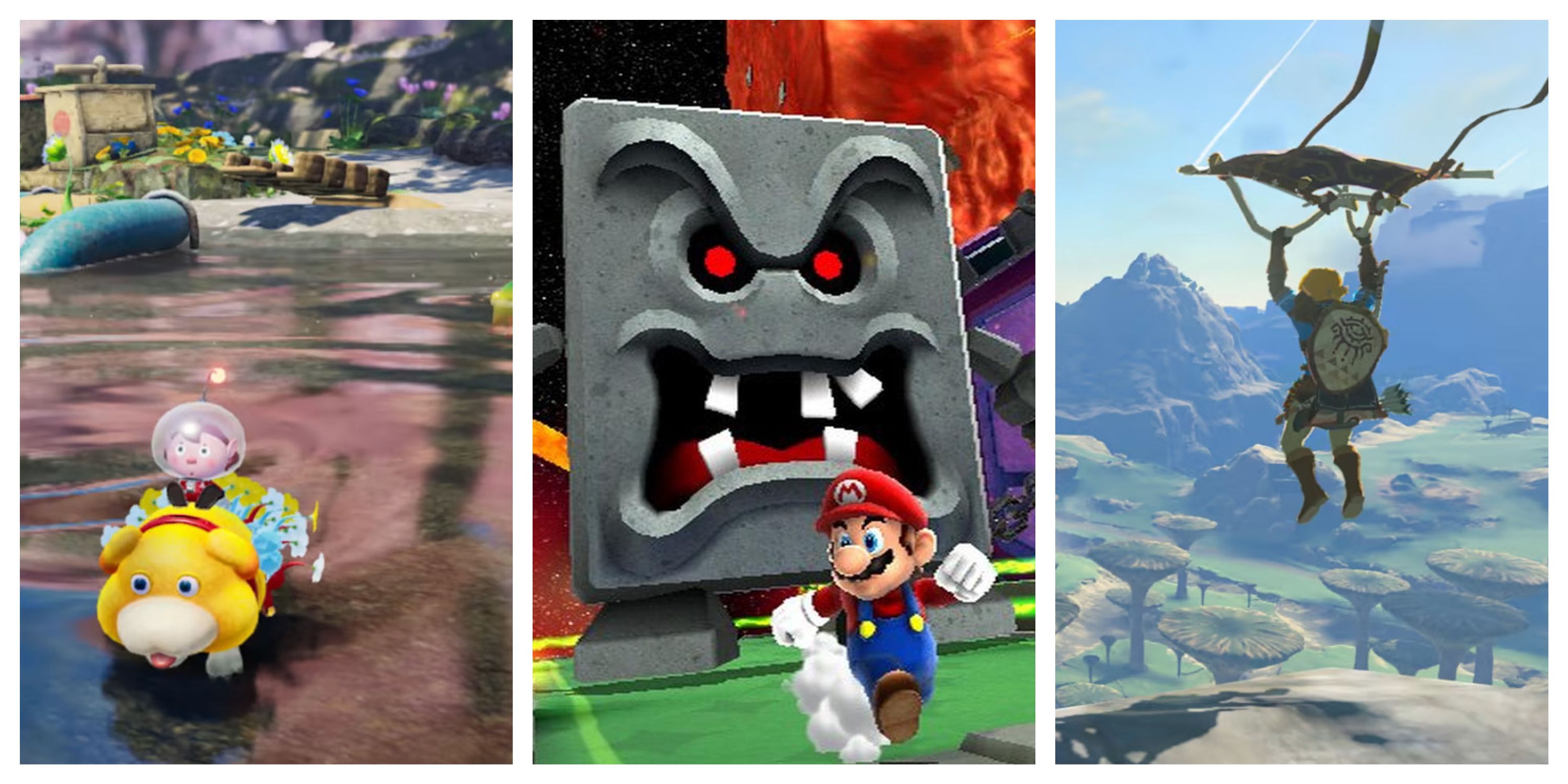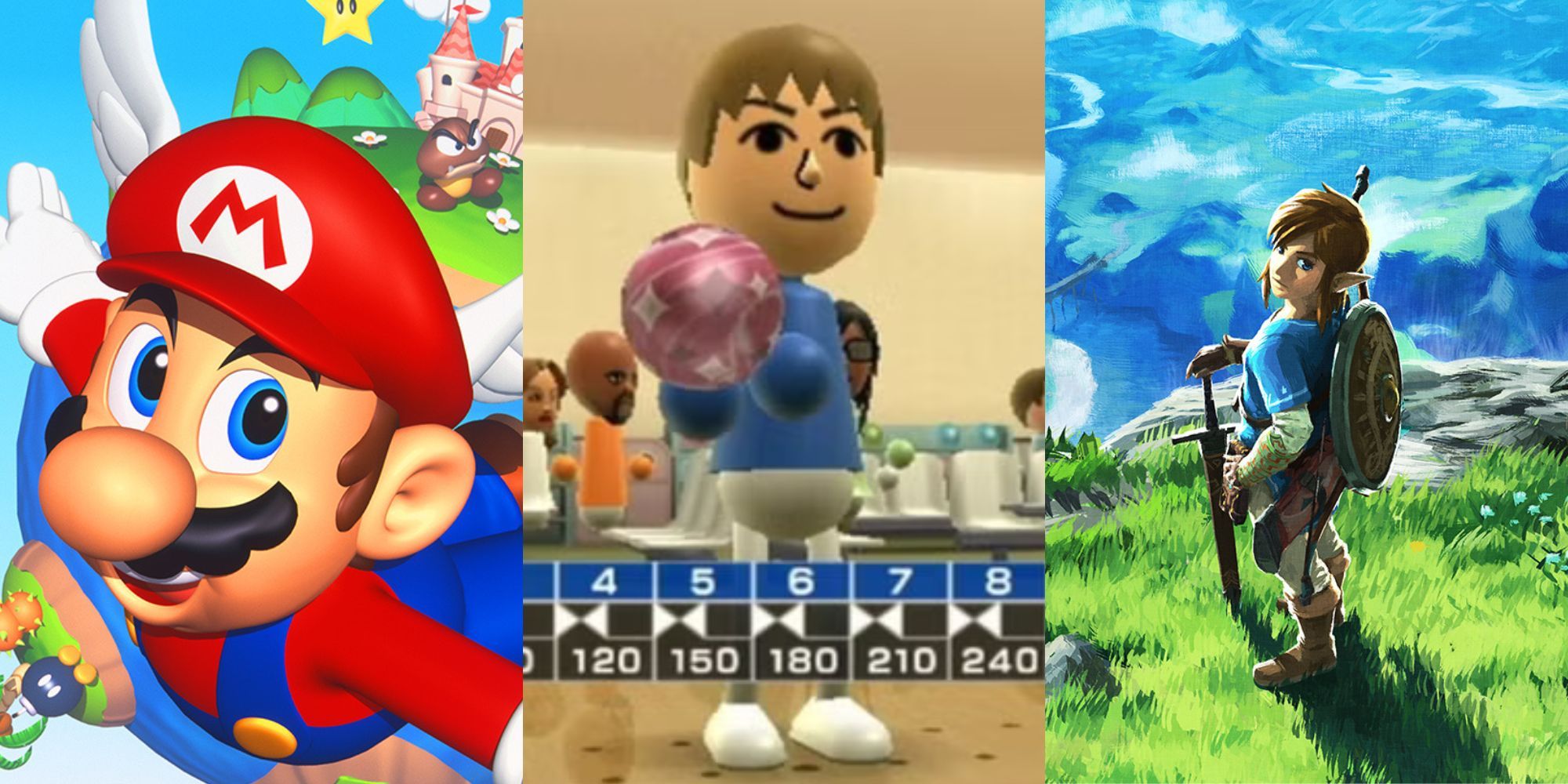Summary
- Some Nintendo games prioritize exploration over linear paths, offering hidden treasures and experiences around every corner.
- Pokemon Legends: Arceus breaks from the traditional Pokemon formula, allowing players to immerse themselves in an untamed wilderness.
- Nintendo titles like Pikmin 4 and Super Mario Odyssey offer dense, puzzle-filled worlds that reward exploration.
There’s something inherently magical about Nintendo worlds when they’re built for wandering. These aren’t just levels—they’re places that breathe, where poking around a corner leads to a hidden power-up, a buried relic, or a jaw-dropping view.
Related
Best RPG On Every Nintendo Console
The golden era of RPGs was on many of these Nintendo consoles. Here are the best RPG offerings each of them delivered.
Over the years, Nintendo has crafted some of the most memorable exploration-driven experiences, often ditching waypoints in favor of player-driven curiosity. Some of these titles redefined what open-ended discovery means, while others quietly reshaped it through clever level design. Either way, they all turn exploration into something personal.
9
Pokemon Legends: Arceus
When Pokemon was Finally About the World
Instead of handing players a pre-determined path and nudging them toward another badge, Pokemon Legends: Arceus does something radical—it lets players wander. Set in the ancient Hisui region long before Poke Centers and Gyms existed, this entry tears down the traditional formula and hands players a satchel, a few Poke Balls, and an intimidating wilderness.
Hisui doesn’t coddle. Alpha Pokemon can and will break bones. Weather conditions affect visibility and traversal. But that’s what makes it work. Exploration feels earned. Players crouch through tall grass, cataloging new species in the Pokedex with actual fieldwork, not just a single battle. Some Pokemon only appear during certain times of day or weather patterns, encouraging careful observation. In many ways, it’s the first mainline Pokemon title where players really feel like researchers, not just glorified gladiators with a science hobby.
8
Xenoblade Chronicles X
A World that Keeps Its Distance, Just Enough to Feel Real
Mira isn’t designed to make players comfortable. It’s beautiful, yes, but it’s also massive, untamed, and sometimes genuinely hostile. Xenoblade Chronicles X drops players into a landscape that dwarfs most RPGs on a sheer scale level—this is a world where level 90 monsters roam freely in level 5 zones, and where flying enemies patrol cliffs before players even unlock the ability to jump high enough to see them properly.
And yet, that’s the point. The early game on-foot exploration demands patience. Fast travel exists but feels like cheating out of something meaningful. Once Skells (mechs) are introduced, exploration expands vertically in jaw-dropping ways, opening up chasms and sky islands that were visible from the start but never reachable. The sense of scale, combined with real-time day-night transitions and reactive wildlife behavior, turns Mira into one of Nintendo’s most complex worlds. It doesn’t just invite players to explore—it demands they learn how to survive while doing it.
7
Pikmin 4
Pikmin are Tiny, but Their Worlds Feel Vast
In Pikmin 4, every nook of the backyard-turned-wilderness feels like it’s harboring a secret. Whether it’s a soda can shelter or a puddle hiding a submerged path, the environments feel alive in a grounded way. Exploration here isn’t about sprawling distances; it’s about density—each square foot of terrain is loaded with puzzles, hazards, and those strangely satisfying collectible treasures.

Related
10 Best Nintendo Sequel Games, Ranked
Nintendo are champions of the video game world, and these sequels to their popular titles prove exactly why that’s the case.
What makes Pikmin 4 especially interesting is how it breaks its own rules. The day-night cycle forces players to explore with urgency, but the introduction of nighttime expeditions flips that idea on its head, adding tension to previously familiar zones. Players aren’t just collecting items—they’re deciphering how this planet works, one leaf-toting follower at a time. Even the base-building mechanics nudge exploration forward, asking players to scout and expand instead of conquer. It’s strategic, it’s charming, and somehow, it always manages to feel new even when you’ve been through the same spot a dozen times.
6
Super Mario 64
Pirates, Paintings, and a Princess in Another Castle
Nobody really knew what a “sandbox” was in 1996, but Super Mario 64 practically built one in Peach’s castle. Each painting wasn’t just a level but a fully explorable mini-world, with multiple stars hidden in places players weren’t always told to look. Unlike older Mario games that were about reaching the flagpole, this one rewarded curiosity. A suspicious slope might hide a slide. A snowman might just be standing on top of an avalanche. And a wall that looks just a little too plain? Probably hiding a secret star behind it.
The hub world itself is deceptively clever. Peach’s castle subtly teaches movement mechanics as players explore it—long jumps to hidden balconies, wall kicks off awkward nooks, and a moat that drains if someone finds the right passage. This wasn’t just platforming anymore. It was raw discovery.
5
Super Mario Odyssey
The Moon is Weird, but so is Everywhere Else
Every kingdom in Super Mario Odyssey is a love letter to curiosity. Whether it’s the vast desert of Tostarena or the hauntingly quiet Ruined Kingdom, each location is designed with verticality, interactivity, and wanderlust in mind. Exploration isn’t gated behind difficulty or gear—it’s driven by “what’s over there?”
Cappy’s possession mechanic is what ties it all together. Players don’t just traverse the world—they become part of it. A sentient fireball can sneak into lava tunnels, a stretchy caterpillar can bridge gaps across poison swamps, and a frog with a high jump can turn an entire room into a platforming playground. Every area is layered with puzzles, mini-stories, and more Power Moons than any one brain can rationally track. It’s not just about reaching a goal, it’s about getting lost and realizing how fun being lost actually is.
4
Metroid Dread
She’s Not Lost, She’s Just… Scanning
Metroid Dread doesn’t pretend to be open world, but its map design is a masterclass in indirect exploration. Samus isn’t collecting icons—she’s charting unknown regions, often by force. What starts as a narrow hallway soon spirals into a complex maze of cleverly hidden secrets, fake walls, and traversal tools that redefine entire areas once unlocked.

Related
Best New Features On The Switch 2, Ranked
The Nintendo Switch 2 a blend of familiarity and novelty; here are some of its most notable new features and system upgrades.
The E.M.M.I. zones shift the tone entirely, turning segments of exploration into deadly puzzles. Players have to scout escape routes and understand terrain under pressure. That contrast between tension and reward adds flavor to every path uncovered. And because this is a Metroid game, backtracking isn’t a chore—it’s a strategic choice. That missile tank you saw hours ago but couldn’t reach? Now it’s a breadcrumb trail calling you back, newly armed and slightly more paranoid. Dread may not be massive in size, but few Nintendo titles make poking around feel this satisfying.
3
The Legend of Zelda: The Wind Waker
A Treasure Map Without the X
The Legend of Zelda: The Wind Waker could’ve coasted on charm alone, but instead it dropped players into a vast Great Sea filled with islands, secrets, and ancient ruins scattered across a blue infinity. What makes exploration in Wind Waker so impactful isn’t just the freedom, but how much trust it puts in the player. There’s no blinking objective marker dragging the camera toward the next dungeon. Instead, there’s a hand-drawn map, a sail, and the endless temptation of the horizon.
Many of the game’s most rewarding discoveries aren’t part of the main story at all. Some are buried treasure chests found by deciphering Tingle’s charts. Others are islands with their own micro-narratives—like the ghost ship that only appears under a full moon, or the Islet of Steel hidden in a cannon-riddled fortress. Even the music changes when the boat picks up speed, as if the sea itself is cheering players on for indulging their wanderlust.
2
Super Metroid
Sometimes, Getting Lost is the Mission
On paper, Super Metroid is just another action platformer. In practice, it’s one of the most intricate labyrinths Nintendo’s ever constructed. Planet Zebes isn’t a backdrop; it’s a character with moods and secrets of its own. The world coils in on itself through environmental storytelling, atmosphere, and an interconnected map that loops, branches, and bottlenecks in ways that subtly challenge the player to remember where they’ve been and take note of what they couldn’t reach before.
Exploration isn’t just optional here—it’s the core of progression. That one hallway with the suspicious wall that looked out of place ten minutes ago? Turns out, a newly acquired Morph Ball bomb can open it. Hidden paths aren’t just secrets; they’re how players survive, with reserve tanks, missile expansions, and suit upgrades stashed behind cleverly disguised fake walls or just barely unreachable ledges. The game never says “go here.” It just says, “go.” And somehow, that’s all players needed.
1
The Legend of Zelda: Breath of the Wild
The Gold Standard of Getting Sidetracked
The Sheikah Towers were supposed to reveal the map, but Breath of the Wild pulls a fast one—it gives players a map while keeping the world a mystery. There are no icons yelling for attention, no strict checklist of things to do. It’s just Hyrule, raw and wild, waiting for players with enough curiosity to tame it.
Stamina becomes a currency, spent on mountains climbed and gliders extended. Shrines double as both reward and compass, always visible on a faraway hill if players dare chase them. Weather isn’t just aesthetic; it actively pushes back. Rain turns rocks slippery. Lightning punishes metal gear. And somewhere among all of that, a dragon might quietly fly overhead while players cook mushrooms by a campfire. It’s the kind of exploration where detours are more memorable than the destination. And that’s what makes it special. Not because Breath of the Wild is massive, but because it makes every step feel meaningful.

More
8 Best Launch Games On Nintendo Consoles
Nintendo knows the importance of a strong first impression, so nearly every console launched with a fantastic game.






